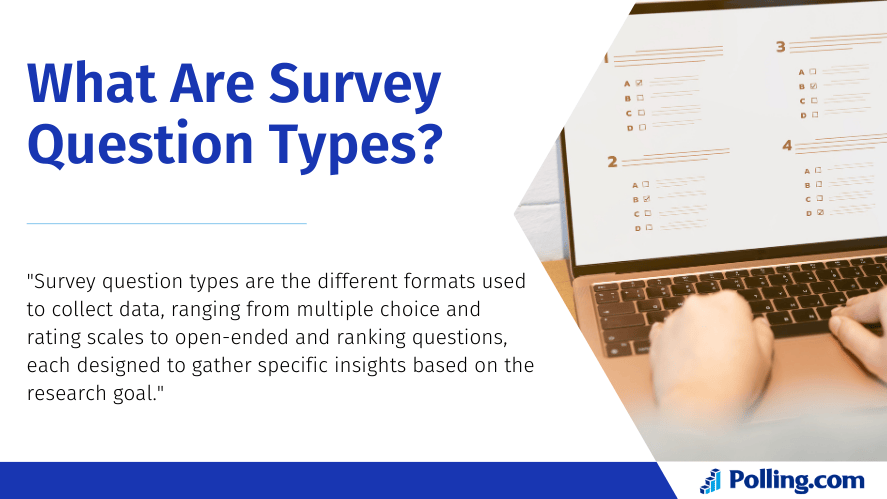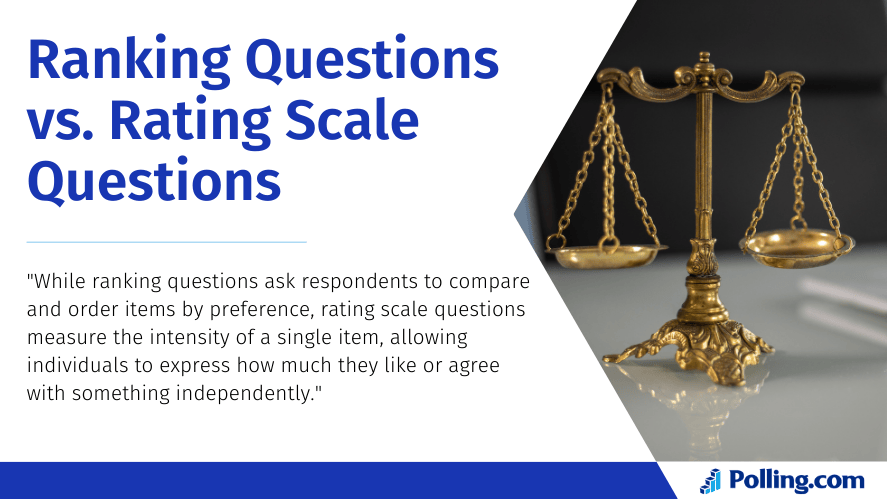
Ranking Questions in Market Research Surveys
Have you ever struggled to figure out what truly matters to your respondents? Ranking questions offer a powerful way to extract preference-based insights by asking users to prioritize items rather than rate them individually. Among the many types of survey questions, ranking questions stand out for their ability to reveal nuanced opinions, especially when it comes to making decisions based on user priorities.
In the world of survey question types, asking the right kind of question is everything. After all, the quality of your survey data hinges not only on what you ask but also on how you ask it. So, where do preference-order questions fit among the different methods of data collection? And when should you use them instead of other formats like rating scales or Likert items?
With that in mind, let’s explore why these prioritization-based prompts are among the most powerful tools in the survey design toolbox.
The Landscape of Survey Question Types

Survey question types are different formats used to gather data from respondents. Each format has its own strengths and limitations, and the selection of a question type significantly impacts the accuracy and usefulness of the results.
Common Categories of Question Types
Survey questions are often categorized based on two axes:
- Closed-ended vs. Open-ended
- Closed-ended: Respondents choose from predefined options
- Open-ended: Respondents answer in their own words
- Quantitative vs. Qualitative
- Quantitative: Data that can be measured numerically (e.g., ratings)
- Qualitative: Descriptive data capturing thoughts, feelings, or opinions
Common Types of Survey Questions
Here’s a quick overview of different types of questions in a survey:
- Multiple Choice Questions – Select one or more predefined answers
- Dichotomous Questions – Yes/No, True/False, Agree/Disagree
- Rating Scale Questions – Rate satisfaction or likelihood (1–5, 1–10)
- Likert Scale Questions – Measure levels of agreement or frequency
- Semantic Differential Scale – Measure the position between two bipolar adjectives
- Matrix Questions – Combine multiple Likert/rating items into a grid
- Demographic Survey Questions – Collect background info (e.g., age, income)
The Need for Ranking Questions
Sometimes, it’s not just about how much someone likes something, but which option they prefer over the others. That’s where preference-ordering questions truly stand out.
What Are Ranking Questions?
To begin with, a ranking question asks respondents to place a set of items in order of preference, importance, or relevance. It’s a way to force prioritization rather than assign ratings to each item independently.

- Drag-and-Drop Interfaces: Used in tools like Typeform or qualtrics ranking questions
- Drop-down Menus: More common in basic survey platforms
- Numeric Input: Assign ranks manually (e.g., 1 = most preferred)
Ranking Questions Examples
- “Rank the following social media platforms from most to least used.”
- “Please rank these product features based on importance.”
Comparison to Other Question Types
| Feature | Ranking | Rating Scale | Multiple Choice |
|---|---|---|---|
| Prioritization | ✅ Yes | ❌ No | ❌ No |
| Ties Allowed | ❌ No | ✅ Yes | ❌ No |
| Comparative Insight | ✅ High | ✅ Moderate | ✅ Low |
When Are Ranking Questions Most Useful?
Use ranking questions when:
- You need to prioritize preferences (e.g., features, services, needs)
- You want to force clear choices
- You want to avoid the “everything is important” bias in rating scales
Ranking Questions vs. Other Common Question Types

- Rating allows all items to be rated equally – leads to ties
- Ranking forces a preference hierarchy
- Use rating scales when each item is independently evaluated; use ranking when order matters
Ranking Questions vs. Likert Scale Questions
- Likert scale captures sentiment/agreement with a single item
- Ranking questions capture relative importance or preference
- Likert is good for attitudinal data; ranking is better for prioritization
Ranking Questions vs. Multiple Choice
- Multiple choice gives one or several selections without preference order
- Ranking provides granular prioritization
- Use multiple choice for categorical data; ranking for comparative data
Comparison Table
| Type | Best For | Limitations |
|---|---|---|
| Ranking | Prioritization | Cognitive load, statistical limits |
| Rating | Measuring intensity | Doesn’t reveal preference order |
| Likert | Attitude/sentiment | No comparative insight |
| Multiple Choice | Categorical answers | No nuance of preference |
Use Cases for Ranking Questions
In Market Research:
- Product feature prioritization
- Price vs. quality trade-off
- Competitor comparison
In Customer Feedback Surveys:
- Ranking pain points in the customer journey
- Preferences for communication channels
- Service tier preferences
In Employee Engagement Surveys:
- Ranking desired workplace benefits
- Prioritizing organizational challenges
In Academic Research:
- Measuring factors in decision-making
- Ranking influences (e.g., peer pressure vs. advertising)
In UX/UI Research:
- Prioritizing interface features
- Ranking layout elements
Advantages of Ranking Questions
- Forces true preferences – avoids neutral or tied answers
- Rich, comparative data – helps stakeholders see what matters most
- Helps structure decisions – e.g., which feature to build first
- Insightful segmentation – different groups may rank differently
Limitations and Challenges of Ranking Questions
- Cognitive Load: Too many options can overwhelm respondents
- Mobile Unfriendliness: Ranking UX may be harder on small screens
- Statistical Limitations: Data is ordinal, not interval
- Instruction Misunderstanding: Some users may not fully understand how to rank
Best Practices for Writing Effective Ranking Questions
- ✅ Use clear instructions
- ✅ Limit items to 5–7
- ✅ Randomize item order to reduce bias
- ✅ Test on mobile devices
- ✅ Make the options meaningfully different
- ✅ Use contextual, relevant topics
Designing Surveys with Ranking Questions

- Use multiple choice or rating scale questions first to shortlist options
- Follow up with a ranking question for prioritization
Avoid Survey Fatigue
- Mix in open-ended or demographic survey questions
- Use a balanced question flow to maintain engagement
Tools and Platforms That Support Ranking Questions
| Tool | Supports Ranking Questions? | Notes |
|---|---|---|
| Google Forms | ⚠️ Limited (via workaround) | No built-in ranking type; use dropdowns or multiple choice grids to simulate ranking |
| SurveyMonkey | ✅ | Intuitive drag-and-drop UI |
| Typeform | ✅ | Slick, mobile-friendly |
| Qualtrics | ✅ | Powerful logic and UI |
| Jotform | ✅ | Offers conditional logic |
| Polling.com | ✅ | Great for live engagement with ranking support |
| QuestionPro | ✅ | Enterprise-level analytics |
Tip: Try qualtrics ranking questions for academic-grade research
How to Analyze Data from Ranking Questions
Ordinal Data Considerations
Ranking data is ordinal, meaning the order matters, but not the magnitude between ranks.
Common Analysis Methods
- Rank Sum Analysis
- Borda Count
- Average Rank Scores
- Weighted Ranking
Visualization Techniques
- Bar graphs (e.g., average rank per item)
- Heatmaps (to spot trends)
- Priority matrices (e.g., importance vs. satisfaction)
Examples of Well-Designed Ranking Questions
Rank Question Example:
“Rank the following features in order of importance when buying a new laptop: Price, Battery Life, Brand, Weight, Screen Size”
Do’s and Don’ts:
✅ Do:
- Use clear, concise options
- Randomize the order
- Provide ranking instructions
❌ Don’t:
- Use too many similar items
- Ask respondents to rank 10+ options
- Use biased wording
When (and When Not) to Use Ranking Questions
Use Ranking Questions When:
- You need prioritization
- You’re conducting resource allocation
- You want to differentiate customer needs
Avoid Ranking Questions When:
- You need absolute values
- The items are unfamiliar to respondents
- The audience may struggle with cognitive load (e.g., young children, elderly)
Alternatives to Ranking Questions
- Rating Scale Questions – When measuring satisfaction
- Likert Scale Questions – For agreement, frequency, or opinion
- Open-ended Questions – For rich, qualitative feedback
- Matrix Questions – Rate multiple items across the same scale
- Hybrid Questions – Allow users to rank and optionally share why
Final Thoughts
Preference-ranking formats offer a distinct advantage when it comes to uncovering real user priorities. While they do have limitations, their strength lies in forcing respondents to make trade-offs something that simple rating scales or multiple-choice questions often fail to capture.
As the demand for actionable insights continues to rise, so does the need to use survey question types more strategically. If you’re not already exploring preference based questions, now’s a great time to start. Platforms like SurveyMonkey, Qualtrics, and even Google Forms (with a few workarounds) make it easier than ever to experiment.
Match your survey question types to your goals, and you’ll collect better data guaranteed.
